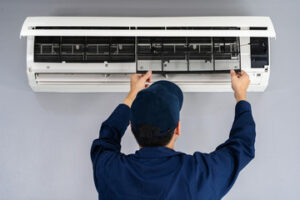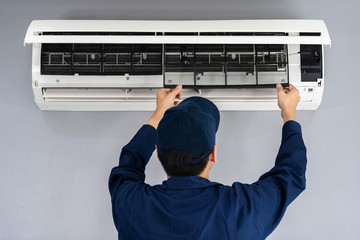With proper maintenance, HVAC systems last longer, operate more efficiently and use less energy. Routine maintenance also prevents problems that lead to costly repairs or early system replacement. Contact HVAC Round Rock for professional help.
Air filters should be cleaned or replaced as needed. Evaporator and condenser coils should be kept clean to ensure optimal efficiency. Thermostats should be calibrated and inspected for broken electrical contacts.
HVAC systems are responsible for regulating the temperature and air quality inside residential, commercial, and industrial buildings and vehicles. They do this by taking in air, heating or cooling it, and redistributing it throughout the building via ductwork and vents. The “H” in HVAC stands for heating, which is done by furnaces or boilers that burn fuel to heat up the air or water.
Ventilation is also an important function of HVAC, which involves a process called “exchange of air” that takes in fresh outdoor air, removes moisture, smoke, odors, heat, dust, airborne bacteria and carbon dioxide, and replenishes oxygen. This is accomplished through ventilation ducts, which are networks of pathways that allow for the exchange of indoor and outdoor air.
The heating component of HVAC is referred to as a furnace or boiler, which uses energy to heat up the air or water in order to warm up a building during colder weather. They are commonly paired with an air conditioner in order to provide both heating and cooling for a home or business.
Depending on the type of furnace, it can be either gas or electric. Gas-powered furnaces are typically more efficient than electric furnaces because they are able to produce more heat with less energy. An additional factor that determines the efficiency of a heating system is its SEER (Seasonal Energy Efficiency Ratio) or HSPF (Heating Seasonal Percentage Performance Factor), which measures an air conditioning or heat pump’s cooling and heating efficiency, respectively.
The most common HVAC systems in today’s homes and businesses are split system HVAC systems, which consist of an indoor unit containing the evaporator coil and blower and an outdoor unit that houses the compressor and condenser coil. These two components are connected by a pipe that runs through the walls and ceiling of the building, and they work together to deliver both heating and cooling for the interior space. A newer and more popular alternative to this type of system is the packaged system, which combines both the heating and cooling components into a single cabinet.
Cooling
When you think of HVAC, your mind might go straight to heating and air conditioning. However, there are several other functions that your system performs to help keep your home comfortable. These include ventilation, air quality and humidity control. The ventilation component is important because it brings fresh air into your home. There are many different types of systems that perform this function, such as fans and ducts.
The air filtration system is another important part of your HVAC because it removes dust, dirt and other debris from the circulating air. This can greatly improve your indoor air quality and prevent allergies. The last main function of an HVAC system is humidity control, which reduces the amount of water in the air. This can help protect your home from damage and prevent mold and mildew from growing.
A cooling system works by removing heat from the indoor air and expelling it outdoors, using a series of coils that are filled with refrigerant. The evaporator coils are usually located in the outdoor unit while the condenser coils are inside the indoor air handler. This process is repeated over and over until the temperature of the indoor air reaches your desired level.
Your air conditioner also uses a system of fans to circulate the refrigerant in the coils. This allows the air to cool down and helps with the condensation process. The compressor, which is also found in the outdoor unit, changes the liquid refrigerant back to a gaseous state. It does this by converting the pressure of the refrigerant. The cooled air is then blown through the vents in your home.
If you’re looking for a new HVAC system, it’s important to do your research and consider all of your options. You’ll want to look for a system with a high Seasonal Energy Efficiency Rating, or SEER, which will indicate how efficient it is. You’ll also want to ensure that the company you choose has a good reputation for customer service and is offering competitive prices. Choosing a high-efficiency, cost-effective system will benefit your family for years to come.
Ventilation
Ventilation is one of the most important aspects of a properly functioning HVAC system. It removes the old stale air from your home and replaces it with fresh outdoor air. This helps to normalize temperatures, reduce humidity levels, and eliminates pollutants like ozone, carbon dioxide, smoke, bacteria, and dust. It also prevents mold from forming in your home and ensures that the air you breathe is healthy and clean.
The ventilation cycle starts at the air return, which sucks in outdoor air and passes it through a filter. This filters out impurities, reducing the amount of dirt that enters your house and allowing your HVAC system to perform more efficiently. It is a good idea to regularly change your filters, as they can get quite dirty over time.
Your HVAC system then blows the filtered air into your home through ductwork and out the return vents. These are usually located at the top of your home and should be checked annually to make sure there are no cracks or holes in the vent stack that allow heat to escape your home. The air then circulates through the evaporator coil and becomes cool, which it distributes to the various rooms through the ductwork via the blower. The refrigerant is then pumped back through the compressor and into its liquid state, where it is pressurized and sent to the condenser coil. As it moves through this coil, the liquid becomes a gas and is expelled through the exhaust vents to help cool your home.
Many modern HVAC systems are designed with zoning capabilities, which allows the heating system to divide your home into different zones that each have their own thermostat settings. This allows you to control the temperature in each zone, boosting comfort and energy efficiency.
The most common HVAC system is the split system, which consists of an air conditioner with a fan and coil based outside your property, with an indoor unit that contains the evaporator and blower (Carrier). It is also possible to use a packaged system that combines both heating and cooling into a single unit installed on the roof or in an attic.
Energy Efficiency
Energy efficiency is the ability of a system to decrease its energy consumption while maintaining or increasing its output. It applies to any device, building, or process that consumes energy, from household appliances to motorized transport and industrial processes. It is usually measured by energy performance standards such as COP (coefficient of performance) for heating appliances and EER (energy efficiency ratio) for cooling equipment. Energy efficiency is also a key driver of greenhouse gas emission reductions and sustainable development.
In homes, energy efficiency measures include upgrading appliances with high ENERGY STAR ratings to replace older models, installing low-flow water fixtures, and insulating the home. In new buildings, design and construction standards for high energy efficiency are built into the structure. In existing buildings, retro-commissioning and submetering can be used to measure the current operating performance of a building and identify opportunities for energy savings.
For the environment, energy efficiency is critical to reducing air pollution from fossil fuel combustion. This pollution contaminates the atmosphere with harmful chemicals that are linked to health problems including respiratory illnesses and cancer. It also contributes to climate change, which requires urgent action by all nations.
The benefits of energy efficiency extend beyond environmental considerations. In addition to reduced electricity bills and lower greenhouse gas emissions, it reduces energy costs, increases comfort levels, and supports economic growth. These benefits are particularly important for low-income households, which spend a disproportionate share of their income on energy.
In terms of the economy, reducing energy costs is one of the most cost-effective strategies for creating jobs and growing a healthy, stable market. Moreover, energy efficiency measures can provide a significant opportunity for social equity, as they benefit the poorest and most vulnerable households. As a result, implementing and expanding energy efficiency is a key path to a clean and prosperous future for all.
